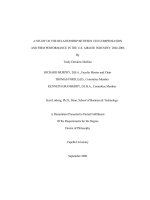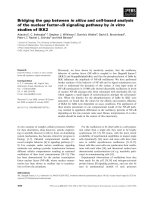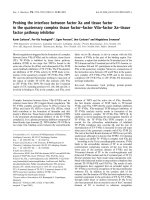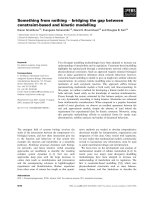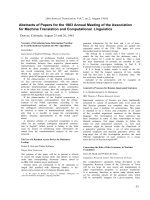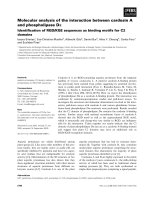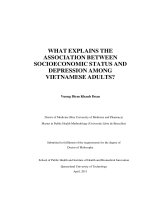What explains the association between socioeconomic status and depression among vietnamese adults
Bạn đang xem bản rút gọn của tài liệu. Xem và tải ngay bản đầy đủ của tài liệu tại đây (2.48 MB, 360 trang )
WHAT EXPLAINS THE
ASSOCIATION BETWEEN
SOCIOECONOMIC STATUS AND
DEPRESSION AMONG
VIETNAMESE ADULTS?
Vuong Diem Khanh Doan
Doctor of Medicine (Hue University of Medicine and Pharmacy)
Master in Public Health Methodology (Universite Libre de Bruxelles)
Submitted in fulfilment of the requirements for the degree of
Doctor of Philosophy
School of Public Health and Institute of Health and Biomedical Innovation
Queensland University of Technology
April, 2011
i
What explains the association between socioeconomic status and depression among Vietnamese
adults?
Keywords
Chronic stress, cross-sectional survey, depression, life time trauma, mastery,
mediating effect, prevalence, psychological resources, recent life events, self esteem,
social support, socioeconomic status, Vietnamese adults.
ii
What explains the association between socioeconomic status and depression among Vietnamese
adults?
Abstract
Background
Depression is a major public health problem worldwide and is currently ranked
second to heart disease for years lost due to disability. For many decades,
international research has found that depressive symptoms occur more frequently
among low socioeconomic (SES) individuals than their more-advantaged peers.
However, the reasons as to why those of low socioeconomic groups suffer more
depressive symptoms are not well understood. Studies investigating the prevalence of
depression and its association with SES emanate largely from developed countries,
with little research among developing countries. In particular, there is a serious
dearth of research on depression and no investigation of its association with SES in
Vietnam. The aims of the research presented in this Thesis are to: estimate the
prevalence of depressive symptoms among Vietnamese adults, examine the nature
and extent of the association between SES and depression and to elucidate causal
pathways linking SES to depressive symptoms
Methods
The research was conducted between September 2008 and November 2009 in
Hue city in central Vietnam and used a combination of qualitative (in-depth
interviews) and quantitative (survey) data collection methods. The qualitative study
contributed to the development of the theoretical model and to the refinement of
culturally-appropriate data collection instruments for the quantitative study. The
main survey comprised a cross-sectional population–based survey with randomised
cluster sampling. A sample of 1976 respondents aged between 25-55 years from ten
randomly-selected residential zones (quarters) of Hue city completed the
questionnaire (response rate 95.5%).
iii
What explains the association between socioeconomic status and depression among Vietnamese
adults?
Measures
SES was classified using three indicators: education, occupation and income.
The Center for Epidemiologic Studies-Depression (CES-D) scale was used to
measure depressive symptoms (range0-51, mean=11.0, SD=8.5). Three cut-off points
for the CES-D scores were applied: ‘at risk for clinical depression’ (16 or above),
‘depressive symptoms’ (above 21) and ‘depression’ (above 25). Six psychosocial
indicators: life time trauma, chronic stress, recent life events, social support, self
esteem, and mastery were hypothesized to mediate the association between SES and
depressive symptoms.
Analyses
The prevalence of depressive symptoms were analysed using bivariate
analyses. The multivariable analytic phase comprised of ordinary least squares
regression, in accordance with Baron and Kenny’s three-step framework for
mediation modeling. All analyses were adjusted for a range of confounders,
including age, marital status, smoking, drinking and chronic diseases and the
mediation models were stratified by gender.
Results
Among these Vietnamese adults, 24.3% were at or above the cut-off for being
‘at risk for clinical depression’, 11.9% were classified as having depressive
symptoms and 6.8% were categorised as having depression. SES was inversely
related to depressive symptoms: the least educated those with low occupational status
or with the lowest incomes reported more depressive symptoms. Socioeconomically-
disadvantaged individuals were more likely to report experiencing stress (life time
trauma, chronic stress or recent life events), perceived less social support and
reported fewer personal resources (self esteem and mastery) than their more-
advantaged counterparts. These psychosocial resources were all significantly
associated with depressive symptoms independent of SES. Each psychosocial factor
showed a significant mediating effect on the association between SES and depressive
iv
What explains the association between socioeconomic status and depression among Vietnamese
adults?
symptoms. This was found for all measures of SES, and for males and females. In
particular, personal resources (mastery, self esteem) and chronic stress accounted for
a substantial proportion of the variation in depressive symptoms between
socioeconomic groups. Social support and recent life events contributed modestly to
socioeconomic differences in depressive symptoms, whereas lifetime trauma
contributed the least to these inequalities.
Conclusion
This is the first known study in Vietnam or any developing country to
systematically examine the extent to which psychosocial factors mediate the
relationship between SES and depression. The study contributes new evidence
regarding the burden of depression in Vietnam. The findings have practical relevance
for advocacy, for mental health promotion and health-care services, and point to the
need for programs that focus on building a sense of personal mastery and self esteem.
More broadly, the work presented in this Thesis contributes to the international
scientific literature on the social determinants of depression.
v
What explains the association between socioeconomic status and depression among Vietnamese
adults?
Table of Contents
Keywords… i
Abstract…… ii
Table of Contents v
List of Figures ix
List of Tables x
List of Abbreviations xiv
Statement of Original Authorship xvii
Contributions to Thesis xviii
Ethical Clearance xix
Acknowledgments xx
CHAPTER 1:INTRODUCTION 1
1.0 Background 1
1.1 Research aim and questions 5
1.1.1 Research aim 5
1.1.2 Research questions 5
1.2 Outline of this Thesis 5
CHAPTER 2:LITERATURE REVIEW 7
2.0 Introduction 7
2.1 Definition of depression 7
2.2 Psycho-behavioural theories of depression 8
2.2.1 Learned helplessness 9
2.2.2 Cognitive constructions of self and reality 9
2.2.3 Response Contingent Positive Reinforcement Theory 10
2.2.4 Psychoanalytic theories 10
2.3 Rating scales for measuring depression 11
2.3.1 Classification 11
2.3.2 Overview of currently-used depression rating scales 14
2.4 International prevalence of depression 19
2.5 The relationship between socioeconomic status and depression 24
2.5.1 Introduction 24
2.5.2 Conceptualising SES 24
2.5.3 Education and depression 26
2.5.4 Occupation and depression 27
vi
What explains the association between socioeconomic status and depression among Vietnamese
adults?
2.5.5 Income and depression 27
2.6 Conceptualising the association between SES, depression and health 30
2.7 The association between stress and depression 33
2.7.1 Conceptualising stress 33
2.7.2 The association between stress and depression 34
2.8 The association between social support and depression 36
2.8.1 ConceptualiSing social support 36
2.8.2 The association between Social support and depression 38
2.9 The association between psychological resources and depression 40
2.9.1 Conceptualising self esteem 40
2.9.2 The association between self esteem and depression 41
2.9.3 Conceptualising mastery 42
2.9.4 The association between mastery and depression 44
2.10 The association between SES and stress, social support and psychological
resources……………… 45
2.10.1 Association between SES and stress 45
2.10.2 Association between SES and social support 47
2.10.3 Association between SES and psychological resources 49
2.11 Research on depression in Vietnam 53
2.12 Hypotheses and conceptual model of the study 55
2.11.1 Hypotheses 55
2.11.2 Conceptual model 56
2.13 Chapter summary 57
CHAPTER 3:RESEARCH METHODS 59
3.0 Introduction 59
3.1 Timeline 59
3.2 Geographic location and scope 59
3.3 Research design……………………………………………………………….61
3.4 Phase 1: Pilot study 62
3. 4.1 Exploratory qualitative research 62
3. 4.2 Pilot study of the quantitative survey 67
3.5 Phase 2: Main survey 75
3.5.1 Sample size 75
3.5.2 Sample selection 76
3.5.3 Training of data collectors 77
3.5.4 Preparing for data collection 77
3.5.5 Data collection 77
3.5.6 Data management 78
3.5.7 Data screening 79
3.5.8 Measures 80
3.5.9 Data analyses 105
3.6 Summary 113
vii
What explains the association between socioeconomic status and depression among Vietnamese
adults?
CHAPTER 4:RESULTS 115
4.0 Introduction 115
4.1 Prevalence of depressive symptoms and depression 116
4.1.1 Overall prevalence of depression 116
4.1.2 Sociodemographic factors and the prevalence of depression 116
4.2 Descriptive (bivariate) analyses of the association between SES, depression
and each of the mediators 122
4.2.1 Socioeconomic status and depression scores (CES-D) 122
4.2.2 Socioeconomic status and lifetime trauma 123
4.2.3 Socioeconomic status and chronic stress 124
4.2.4 Socioeconomic status and recent life events 125
4.2.5 Socioeconomic status and social support 126
4.2.6 Socioeconomic status and self esteem 127
4.2.7 Socioeconomic status and mastery 128
4.3 Mediation analyses: The causal steps approach - three steps in Baron and
Kenny’s framework 129
4.3.1 Step 1: The Total effects of SES on depression 129
4.3.2 Step 2: Multiple regression of potential mediators on SES 133
4.3.3 Step 3: Multiple regression of CES-D score on potential mediators
- controlling for the effect of SES 146
4.4 Estimating the size and significance of the indirect or mediated effects 150
4.4.1 The mediated effect of lifetime trauma on SES and depression 151
4.4.2 The mediated effect of chronic stress on SES and depression 155
4.4.3 The mediation effect of recent life events on SES and depression 158
4.4.4 The mediation effects of social support on SES and depression 162
4.4.5 The indirect effects or mediated effect of self esteem on SES and
depression 166
4.4.6 The indirect effect or mediated effect of mastery on SES and
depression 169
4.5 Percentage mediation of total effects of SES on CES-D: summary 172
4.6 Summary 184
CHAPTER 5:DISCUSSION 187
5.0 Introduction 187
5.1 Prevalence of depressive symptoms and depression 187
5.1.1 Prevalence of being ‘at risk for clinical depression’ 188
(CES-D≥ 16) 188
5.1.2 Prevalence of depressive symptoms (CES-D > 21) and depression
(CES-D > 25) 190
5.1.3 Gender and depression……………………………………………… 192
5.1.4 Age and depression ………………………………………………… 193
5.1.5 SES and the prevalence of depression……………………………… 195
5.2 Psychosocial mediators of the SES-depression relationship 197
viii
What explains the association between socioeconomic status and depression among Vietnamese
adults?
5.2.1 Association between SES and levels of depressive symptoms 197
5.2.2 The mediating role of stress 198
5.2.3 The mediating role of social support 203
5.2.4 The mediating role of self esteem 206
5.2.5 The mediating role of mastery 208
5.2.6 Comparing mediating effects of different psychosocial factors 213
5.2.7 Gender difference in mediating effects 219
5.3 Study strengths, limitations and implications for further research 219
5.3.1 Strengths 219
5.3.2 Study limitations and implications for further research 221
5.4 Implications for mental health policy in Vietnam 224
5.5 Conclusion 232
BIBLIOGRAPHY 234
APPENDIX A: GUIDELINES FOR EXPLORATORY QUALITATIVE
RESEARCH ……………………………………………………………………….267
APPENDIX B: SURVEY QUESTIONNAIRE 271
APPENDIX C: RESULTS OF EXPLORATORY QUALITATIVE RESEARCH 293
APPENDIX D: RESULTS OF PILOT QUANTITATIVE RESEARCH 303
APPENDIX E: CONFIRMATORY FACTOR ANALYSIS 324
APPENDIX F: BIVARIATE RELATIONSHIPS BETWEEN EACH SES
INDICATOR AND THE CONTROL VARIABLES (AGE, MARITAL STATUS,
SMOKING, DRINKING AND CHRONIC DISEASES) 327
APPENDIX G: VIETNAM MAP AND LOCATION OF STUDY SITE 333
APPENDIX H: PICTURES OF HOUSEHOLD BOOKLET AND TRANING
DATA COLLECTORS 335
ix
What explains the association between socioeconomic status and depression among Vietnamese
adults?
List of Figures
Figure 2.1. Classification of rating scales for depression ………………………… 12
Figure 2.2. Theoretical model of the association between socioeconomic status,
depression and health outcomes 32
Figure 2.3. Conceptual model of the association between SES and depression 56
Figure 3.1. Research design of the study 61
Figure 3.2. Histograms of lifetime trauma scale by sex 86
Figure 3.3. Histograms of chronic stress scale by sex 89
Figure 3.4. Histograms of the recent life events scale by sex 92
Figure 3.5. Histograms of the social support scale by sex 94
Figure 3.6. Histogramsof self esteem scale by sex 96
Figure 3.7. Histograms of the mastery scale by sex…………………………….….98
Figure 3.8. Histograms of CES-D scale by sex 104
Figure 3.9. Mediational model using Baron and Kenny’s (1986) notation 107
Figure 4.1. Prevalence of depressive symptoms (CES-D > 21) by education (%) . 119
Figure 4.2. Prevalence of depressive symptoms (CES-D > 21) by occupation (%) 120
Figure 4.3. Prevalence of depressive symptoms ( CES-D > 21) by income (%) 121
x
What explains the association between socioeconomic status and depression among Vietnamese
adults?
List of Tables
Table 2.1 Diagnostic schedules assessing depression within currently-used
diagnosis systems……………………………………………………………… 16
Table 2.2 Dimensional rating scales: clinician- or observer-rated scales for
depression…………………………………………………………………… 17
Table 2.3 Self-rated scales for depression……………………………………… 18
Table 3.1 Pilot study: internal consistency of scales………………………………. 71
Table 3.2. Pilot study: Summary of the fit statistics of mastery scale……………… 72
Table 3.3 Ordinary Least Squares Regression of CESD score on income (controlled
for age), comparing the two models: values of missing income included
(substituted) and excluded…………………………………………………… 80
Table 3.4 SES distribution of the sample………………… 82
Table 3.5 Frequency of lifetime trauma items…………………………………… 84
Table 3.6 Descriptive statistics of the lifetime trauma scale…………………… 85
Table 3.7 Frequency of chronic stress items……………………………………… 87
Table 3.8 Descriptive statistics of chronic stress scale……………………………. 88
Table 3.9 Frequency of recent life event items……………………………………. 90
Table 3.10 Descriptive statistics of the recent life event scale……………………. 91
Table 3.11 Descriptive statistics of the social support scale………………………. 93
Table 3.12 Descriptive statistics of the self esteem scale…………………………. 95
Table 3.13 Descriptive statistics of the mastery scale…………………………… 97
Table 3.14 Mean age (SD) and age group distribution of the sample……………. 99
Table 3.15 Marital status distribution of the sample…………………………… 100
Table 3.16 Smoking status distribution of the sample………………………… 100
Table 3.17 Alcohol consumption distribution of the sample…………………… 101
xi
What explains the association between socioeconomic status and depression among Vietnamese
adults?
Table 3.18 Chronic diseases distribution of the sample………………………… 102
Table 3.19 Descriptive statistics of the CES-D scale……………………………. 103
Table 3.20 Simple Linear Regression of CES-D score on SES indicators………. 106
Table 3.21 Bivariate inter-correlation matrix of mediator variables…………… 110
Table 3.22 Ordinary least squares regression of CES-D score on education without
and with adjusted for clusters in quarter and in interviewer in females (all
models adjusted for age)…………………………………………………… 113
Table 4.1 Percentage of ‘category at risk for clinical depression’, percentage with
depressive symptoms and percentage with depression by demographic
characteristics and SES………………………………………………………. 117
Table 4.2 CES-D scale: mean scores (and 95% CI) by SES for males and
females……………………………………………………………………… 123
Table 4.3 Lifetime trauma scale: mean scores (and 95% CI) by SES for males and
females……………………………………………………………………… 124
Table 4.4 Chronic stress scale: mean scores (and 95% CI) by SES for male and
female…………………………………………………………………………125
Table 4.5 Recent life events scale: mean scores (and 95% CI) by SES for males and
females……………………………………………………………………… 126
Table 4.6 Social support scale: mean scores (and 95% CI) by SES for males and
females……………………………………………………………………… 127
Table 4.7 Self esteem scale: mean scores (and 95% CI) by SES for males and
females……………………………………………………………………… 128
Table 4.8 Mastery scale: mean scores (and 95% CI) by SES for males and
females……………………………………………………………………… 129
Table 4.9 Ordinary least squares regression of CES-D score on SES…………… 130
Table 4.10 Ordinary Least Squares Regression of Lifetime trauma score on SES. 133
Table 4.11 Ordinary least squares regression of chronic stress score on SES…….135
Table 4.12 Ordinary least squares regression of recent life events score on SES 138
Table 4.13 Ordinary least squares regression of social support score on SES……. 140
xii
What explains the association between socioeconomic status and depression among Vietnamese
adults?
Table 4.14 Ordinary least squares regression of self esteem score on SES………142
Table 4.15 Ordinary least squares regression of mastery score on SES…………. 144
Table 4.16 Ordinary Least Squares Regression of CES-D on possible mediators
(psychosocial resources) when controlling for the effect of education……… 146
Table 4.17 Ordinary least squares regression of CES-D on possible mediators
(psychosocial resources) when controlling for occupation………………… 148
Table 4.18 Ordinary least squares regression of CES-D on possible mediators
(psychosocial resources) when controlling income………………………… 149
Table 4.19a Ordinary least squares regression of CES-D on SES indicators and the
mediated effect of lifetime trauma for males………………………………… 153
Table 4.19b Ordinary least squares regression of CES-D on SES indicators and the
mediated effect of lifetime trauma for females………………………………. 154
Table 4.20a Ordinary least squares regression of CES-D on SES indicators and the
mediation effects of chronic stress among males……………………………. 156
Table 4.20b Ordinary least squares regression of CES-D on SES indicators and the
mediation effect of chronic stress among females………………………… 157
Table 4.21a Ordinary least squares regression of CES-D on SES indicators and the
mediated effects of recent life events among males…………………………. 160
Table 4.21b Ordinary least squares regression of CES-D on SES indicators and the
mediated effect of recent life events among females………………………… 161
Table 4.22a Ordinary least squares regression of CES-D on SES indicators and the
mediation role of social support among males………………………………. 164
Table 4.22b Ordinary least squares regression of CES-D on SES indicators and the
mediation effects of social support among females………………………… 165
Table 4.23a Ordinary least squares regression of CES-D on SES indicators and the
mediation of self esteem among males………………………………………. 167
Table 4.23b Ordinary least squares regression of CES-D on SES indicators and the
mediation role of self esteem among females……………………………… 168
Table 4.24a Ordinary least squares regression of CES-D on SES indicators and the
mediation effect of mastery among males…………………………………… 170
Table 4.24b Ordinary least squares regression of CES-D on SES indicators and the
mediation effect of mastery among females…………………………………. 171
xiii
What explains the association between socioeconomic status and depression among Vietnamese
adults?
Table 4.25 Summary of the percentages of total effects (education on CES-D)
mediated by psychosocial resources…………………………………………. 173
Table 4.26 Summary table: percentages of total effects (occupation on CES-D)
mediated by psychosocial resources…………………………………………. 176
Table 4.27 Summary table: percentages of total effects (income on CESD) mediated
by psychosocial resources……………………………………………………. 179
Table 4.28 Average percentages of total effects (SES on CES-D) mediated by
hypothesised mediators………………………………………………………. 182
xiv
What explains the association between socioeconomic status and depression among Vietnamese
adults?
List of Abbreviations
ACE Adverse childhood experiences
BDI Beck Depression Inventory
BRAC Bangladesh Rural Advancement Committee
CDS Carroll Rating Scale for Depression
CES-D Center for Epidemiologic Studies-Depression Scale
CFA Confirmatory factor analysis
CFI Comparative fit index
CHD Coronary Heart Disease
CI Confidence interval
CIDI Composite International Diagnostic Interview
CIS-R Clinical Interview Schedule- Revised
DACL Depression Adjective Check Lists
D-ARK Depression-Arkansas Scale
DASS Depression Anxiety Stress Scale
DIGS Diagnostic Interview for Genetic Studies
DIS Diagnostic Interview Schedule
DSM-III-R Diagnostic and Statistical Manual of Mental Disorders, Third
Edition, revised
DSM-IV-TR Diagnostic and Statistical Manual of Mental Disorders, Fourth
Edition, text revision
EFA Exploratory factor analysis
FA Factor analysis
xv
What explains the association between socioeconomic status and depression among Vietnamese
adults?
GFI Goodness of Fit Index
GMSE Geriatric Mental State Examination
Ham-D Hamilton Rating Scale for Depression
HPA Hypothalamic–pituitary–adrenocortical axis
ICC Intra-class correlation coefficient
ICD-10 International Classification of Diseases–10th revision
ICPE International Consortium of Psychiatric Epidemiology
IDD Inventory to Diagnose Depression
IDS-C Inventory of Depressive Symptomatology- Clinician
Administered
IDS-SR Inventory of Depressive Symptomatology- Self Reported
KECAS Korean Epidemiologic Catchment Area Study
MADRS Mongomety-Asberg Depression Rating Scale
MDD Major depressive disorder
MINI Mini-international Neuropsychiatric Interview
MSPSS Multidimensional Scale of Perceived Social Support
NCS US National Co-morbidity Study
NFI Normed Fit Index
NS Not significant
OLS Ordinary least squares
OR Odds ratio
PCA Principal component analysis
PHQ-2 Patient Health Questionnaire Two-item Screener
PIC Positive influences in childhood
PRIME-MD Primary Care Evaluation of Mental Disorders
xvi
What explains the association between socioeconomic status and depression among Vietnamese
adults?
RMSEA Root Mean Square Error of Approximation
RSES The Rosenberg Self-Esteem Scale
SADS Schedule for Affective Disorders and Schizophrenia
SCID-I Structures Clinical Interview for DSM-IV Axis I Disorders
SDDS-PC Symptom-Driven Diagnostic System for Primary Care
SCAN Schedule for Clinical Assessment in Neuropsychiatry
SEM Structural Equation Modelling
SES Socioeconomic status
SAM Sympathetic adrenal–medullary system
SD Standard deviation
SWAN Study of Women’s Health Across the Nation
VBSP Vietnam Bank for Social Policies
VO Village Organisation
WHO World Health Organization
Zung SDC Zung Self-Rating Depression Scale
What explains the association between socioeconomic status and depression among Vietnamese
adults?
Contributions to Thesis
The work presented in this thesis was conducted by the author under the supervision
of Professor Gavin Turrell (Principal Supervisor) and Professor Michael Dunne
(Associate Supervisor) at the School of Public Heath, Queensland University of
Technology, Australia, and A. Professor Vo Van Thang (Associate Supervisor), at
Hue College of Medicine and Pharmacy, Vietnam.
The work conducted by the author included:
Conceptualisation of research program, design and methodology; development of
funding submissions; submission of ethics applications; measurement design and
development; data collection, data management and analyses; interpretation of
results and the preparation of this thesis.
This PhD research program and the study presented in this thesis was conducted with
funding support from Atlantic Philanthropies.
What explains the association between socioeconomic status and depression among Vietnamese adults? xix
Ethical Clearance
The study presented in this thesis was awarded ethical clearance by the University
Human Research Ethics Committee (UHREC) at the Queensland University of
Technology, Australia (ethic approval number 0800000642) and the Research Ethics
Committee of Hue University of Medicine and Pharmacy, Vietnam.
What explains the association between socioeconomic status and depression among Vietnamese adults? xx
Acknowledgments
This Thesis would not have been possible without the essential and gracious
support of many individuals. My deepest gratitude is reserved for Professor Gavin
Turrell, my Principal Supervisor and mentor. Throughout the duration of this project,
he was always available to provide useful advice and assistance. His superior
capacity, ongoing interest and enthusiasm for the topic were an important factor in
the completion of this thesis.
I owe a debt of gratitude to Professor Michael Dunne and A/Professor Vo Van
Thang, my Associate Supervisors. Without their continuing support, intellectual
advice and encouragement, critical aspects of this research would have been difficult
to successfully achieve.
I am thankful to Mrs Jill Nalder. As the administration officer of the QUT-
Vietnam Public Health Program, she has always been very kind and thorough in
taking care of me during my PhD research.
I also owe a debt of appreciation to the health staff at the Hue community
health centres in Vietnam. Without their contribution, data collection for this
research could not have been conducted successfully. My gratitude must also go to
the Hue residents for their enthusiasm and openness in responding to the study’s
questionnaire: their contributions have helped produce a valuable and useful piece of
research that will hopefully benefit all residents of Hue and Vietnam.
I am very much thankful to Atlantic Philanthropies for their generous provision
of funds for this study.
What explains the association between socioeconomic status and depression among Vietnamese adults? xxi
I am forever grateful to my parents. Their never ending love, great effort and
sacrifice have created an aspiration for living and studying in me.
Lastly, I would like to thank my husband, Thuy. Throughout the duration of
this Thesis, he has provided endless support and encouragement. This work would
not have been possible without his devotion to the care of my children when I was
far away.
Chapter 1: Introduction 1
Chapter 1: Introduction
1.0 BACKGROUND
In the last decade, there has been a growing interest in the burden of chronic
and disabling health conditions, including mental health disorders (Eaton et al.
2008). Researchers have shown that neuropsychiatric conditions are among the
leading causes of disability worldwide, accounting for about one-third of years lost
due to disability among adults aged 15 years and over (WHO, 2004). Among the
neuropsychiatric conditions, depressive symptoms have been classified as the leading
global cause of years of health lost (WHO, 2004). The burden of mental illness is
substantial and studies suggest that the prevalence of mental disorders is likely to
increase in coming years. By 2030, it is estimated that unipolar depression will
become the leading cause of lost disability-adjusted life years in the world (WHO,
2008).
The burden of depressive illness on society exists not only as a consequence of
its disability and impairment, but also due to its prevalence. In the 1990s, a number
of important cross-national articles showed that mental disorders were highly
prevalent (Weissman et al, 1994, 1996, 1997). Studies continue to demonstrate that
the prevalence of mental disorders is higher than that of any other class of chronic
conditions (Kessleret al. 2001; Murrayand Lopez 1996). Specifically, depressive
disorders have been established as the most common mental health disorders in the
community (Andrade et al. 2003; Waraich et al. 2004; Weissman , Myers , and
Harding 1978; Weissman, Myers, and Thompson 1981). According to the WHO
(2010), it is estimated that at any given time approximately 5-10% of the population
suffers from identifiable depression that requires psychiatric or psychosocial
intervention. The lifetime risk of developing depression is 10-20% among females
and slightly less among males (WHO 2010).
The causal mechanisms linking depression to negative health outcomes include
several inter-related behavioural and physiological pathways. Depressive symptoms
